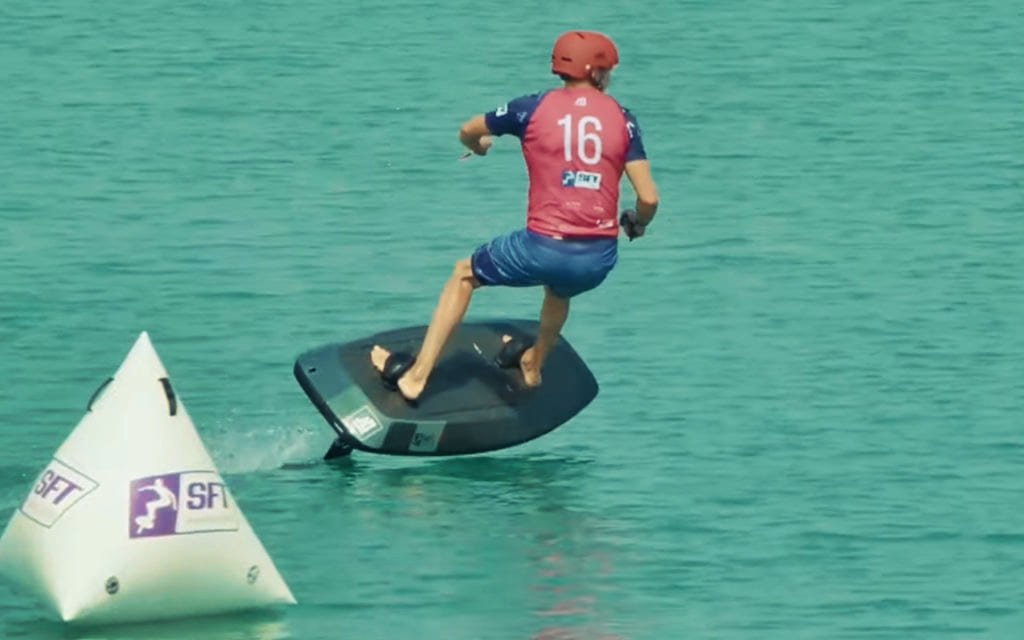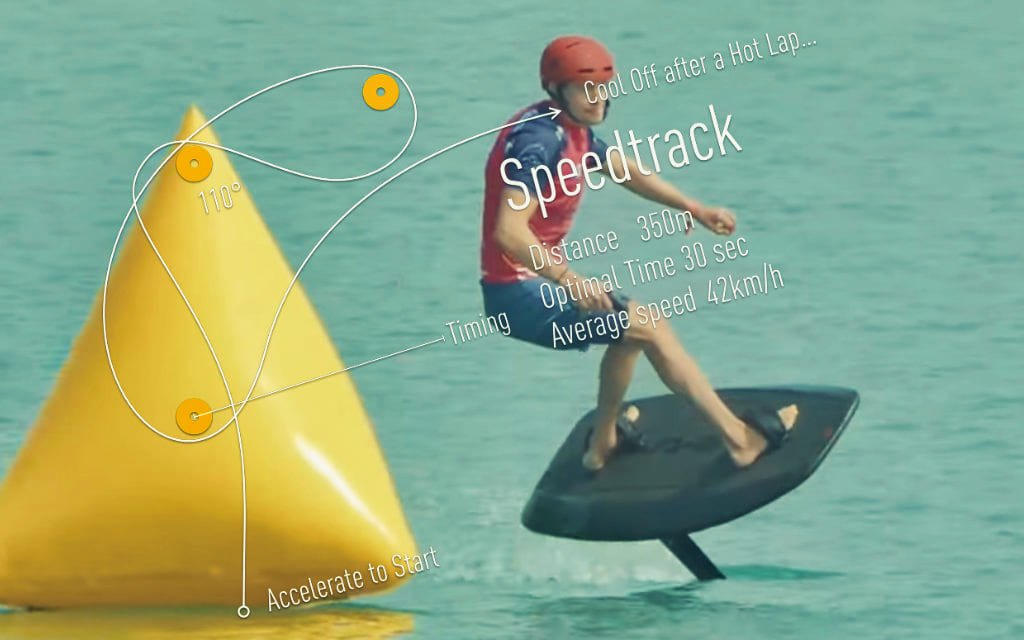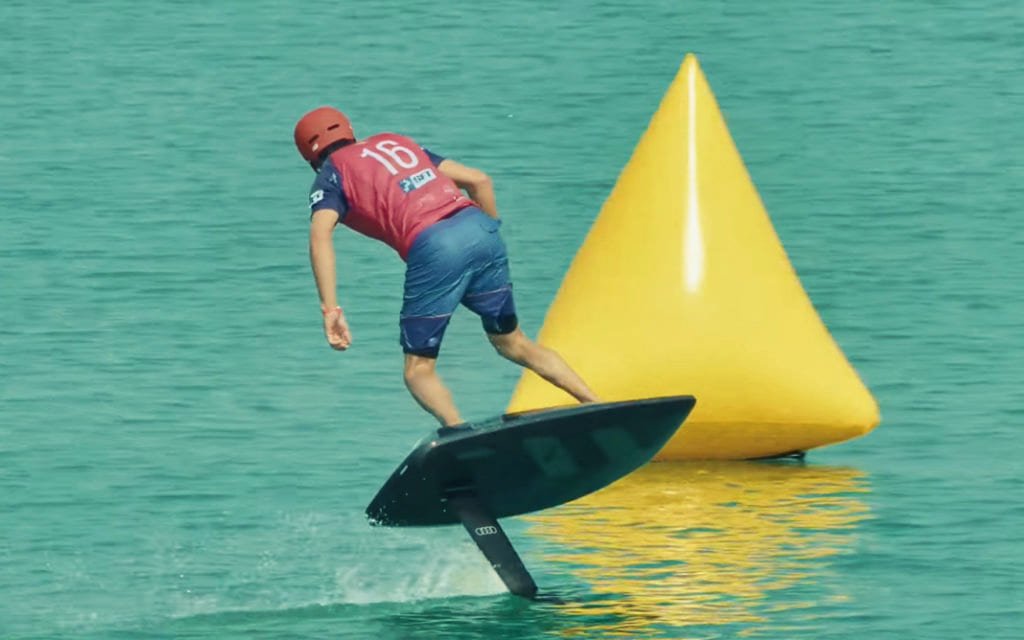eFoil race explained simply: rules, categories, technical checks, flags, penalties, course design, weather limits, plus practical tips for training.
What is an eFoil race?
An eFoil race is a competitive course race on electrically powered hydrofoil boards (known as eFoils for short). The board lifts above the water surface, friction decreases, control and line are decisive.
The sport relies on clean, efficient electric motors and attracts beginners and professionals alike. Events aim for fair competition, safety, and clear class divisions.
Event formats and procedure
Many events run a technical slalom course in one direction, combining time trials and knockout rounds. At the Dubai Efoil Festival 2024, a maximum of two riders were on the course at the same time. This reduces risk and increases measurability.
In more recent events, only one rider per time measurement took to the course.
Key roles in race operations
- Race director: Overall management, schedule changes, cancellation or restart.
- Head referee: Rule enforcement, timekeeping, result approval.
- Flag marshal: Signals on the course.
- Technical commissioner: Equipment and safety checks.
- Medical director & rescue: First aid, water rescue, eligibility to participate.
Technical check: What is actually checked
The pre-inspection takes place before the start. You either submit maintenance records or a self-declaration of functionality. Random checks by officials are of course possible. Failed? No start until the problem is fixed.
Mandatory checkpoints for your equipment:
- Board & battery box: No cracks, no leaks.
- Battery: Serial condition, no damage, no corrosion or overheating; electrical integrity.
- Mast: Statically solid; maximum height limited depending on class.
- Foil wing: no sharp edges, no significant damage.
- ESC/electrics: sealed, corrosion-free, functional.
- Cables: insulated, no exposed wires.
- Hand controller: fully functional, safe zero throttle when trigger is not pressed.

eFoil racing safety equipment
- Helmet with CE, FIM, or equivalent certification, without structural defects.
- Buoyancy aid with > 50 N, adjusted to fit.
Non-compliant equipment will result in disqualification (or until remedial action has been taken).
Branding and attachments: Sponsor vinyls, flags, fabric attachments, and other additional parts are subject to registration and approval. They must not impair visibility, safety, or technology. Prohibited parts must be removed.
Classes, license, material rules
eFoil race License
Until now, no racing license was required; in the future, a license requirement will be introduced.
eFoil races: Rider categories
- Men aged 16 and over, divided internally into high/low speed.
- Women aged 16 and over.
- Junior under 16 years of age.
Production model vs. semi-open
A pure production model category (stock model) requires unmodified production eFoils that can be purchased and delivered at short notice; unauthorized modifications will result in a switch to semi-open or disqualification. In some cases, this stock class has not been part of the program to date and is determined by the respective organizer.
The semi-open category allows modifications within clear limits.
Essential semi-open limits:
Battery
- UN38.3 compliant, commercially available eFoil batteries.
- Max. voltage 60 V, in special cases up to 70 V on request.
- Capacity ≥ 15 Ah.
- No significant damage; no overheating ≥ 50 °C for > 15 min; dry, without moisture.
- An approved backup battery is permitted.
Mast & hull
- Securely fastened, statically solid.
- Mast length 50–100 cm (top of board to motor shaft).
- Material free choice; rear edge not sharpened.
- Hull length free choice, but securely fixed.
Motor & drive
- Shaft power within the range of commercially available eFoils.
- Propeller: Standard or custom, Ø ≤ 15 cm, not excessively sharp; material free choice.
- Jet drives permitted; nozzle ≤ 15 cm.
Wings
- Edges rounded as in the original, no aggressive sharpening.
- Material free (carbon, aluminum, etc.).
- Custom wings permitted, including non-branded; designs not publicly available must be approved and announced in advance.
Front and stabilizer wing
- One front wing and one stabilizer wing per system.
- Pitch shims permitted, must be securely fastened.
Wing shims
Permitted, commercially available or open source, with angle and position specified; no safety risks, no excessive speed gains.
Board
- Volume 20–150 L.
- Length 50–200 cm (bow–stern).
- Shape modifications permitted, compatibility with mast systems unrestricted.
- Must be buoyant with battery inserted and without damage. Defective boards = disqualification until re-approval.
- Non-publicly available or individual designs must be declared.
Footstraps
Permitted, securely attached, easy to release in the event of a fall; no boot or lock-in systems.
Controller
One-hand control device, mechanical/digital; failsafe throttle at 0%, no interference signals.
Anti-breach systems
Prohibited in time trials and races, must be deactivated/unplugged.
Handlebars
Not permitted; no additional support structures or ropes for support. Side board straps max. 10 cm from board.
Mandatory reporting of modifications
- Deadline: ≥ 10 days before the start of the race.
- Equipment form must be completed in full.
- Penalties for violations: time penalty up to disqualification.
- Availability/transparency: Modifications must be reproducible or open source; proof may be required.
Although not from the E-SURFER YouTube channel, here is the eFoil race from Abu Dhabi on October 25, 2025. The winner was Justin Bait (USA) on Fliteboard, followed by Clemens Kresser on Aerofoils:
Navigation, course discipline, and flags
Buoy rules
- White buoy on the left, orange buoy on the right; other colors will be explained in the briefing.
- Missed buoy: Return and take it correctly or head for the penalty buoy; otherwise, up to 30 seconds penalty.Collision/cutting without correction: immediate penalty, disqualification if repeated.
eFoil race Flags
- Green: Course clear, race underway.
- Yellow: Danger, reduce speed, hold position.
- Red: Abandoned, proceed carefully to the start area.
- Checkered: Finish line, coast to a stop and enter the pit area.
Fall protocol and re-entry
- Hand on head as “OK signal.” Without a signal, officials may neutralize.
- Swim safely to the board, watch out for traffic, then continue at the point of re-entry. No shortcuts.
- Need help? Raise both arms above your head. Yellow or red flag possible.
- Multiple crashes may result in disqualification from the race for safety reasons.
Multiple riders, right of way, overtaking
- Leader has priority and the “inside line” in turns.
- No overtaking in tight corners > 90°. In wide corners ≤ 90°, overtake on the outside, keeping your distance.
- Passing zones are marked; close dive bombing will be penalized as reckless.
- Within 10 m before a corner, passing the leader on the inside = reckless → penalty up to disqualification.
- Lapped or slower riders make way. Use signals when stopping/leaving.
Start numbers, paddock, service, storage
- Start numbers are assigned; 01–99 or more. Display on equipment clearly visible, otherwise penalty/DQ.
- Paddock area: 2.5 m² per rider, with shelter, seating, and electricity.
- Manufacturers/teams may operate service centers in the paddock.
- Multi-day events: secure storage with surveillance.
eFoil race: Anti-doping, alcohol
- Based on WADA guidelines. Violations → immediate disqualification.
- Alcohol tests possible before/during the event. Positive → disqualification. Refusal is considered positive.
Penalties and protests
- Missed buoy without correction: + 30 s.
- Unsportsmanlike conduct: warning up to DQ.
- Safety violation: DQ until remedied.
- Protest: in writing within 1 hour after the end of the race to the chief referee; fee 200 EUR / 200 USD / 700 AED; refund if upheld.
Course design, safety, and weather
eFoil race course parameters
- At least 45 seconds per lap under standard conditions.
- Course length ≥ 1 km per lap.
- Water depth ≥ 1.25 m throughout, ≥ 15 m distance from shallow areas.
Buoy placement and finish line
Buoys clearly visible and marked on the race map; start/finish clearly marked.

eFoil race: Rescue & Medical
At least two safety boats/jet skis with trained personnel, including rescue equipment and radio.
Medical area with free access for rescue vehicles; for large heats/finals, ambulance on site.
Neutralization/cancellation of the eFoil race
Yellow for accidents, red for serious incidents, return to safety zone/start area, restart or cancellation at the discretion of the race director.
Weather protocol
Interruption/postponement in unsafe conditions.
Guidelines: > 15 knots wind or > 30 cm waves → race postponed/cancelled. Communication via board or directly by race director.
Frequently asked questions about eFoil races
Do I need a license for an eFoil race?
Not at present. A license requirement has been announced for future events.
Can I install a handlebar?
No. No additional support structures. Side straps max. 10 cm from the board.
How do I report modifications?
No later than 10 days before the event using the equipment form. Failure to report = penalty up to DQ.
What happens if I miss a buoy?
Return to the buoy or sail to the penalty buoy. Otherwise, up to + 30 s.
How many riders are on the course at the same time?
A maximum of two. Recently, usually only one rider per time measurement.
Water depth and course length
At least 1.25 m depth and ≥ 1 km per lap, lap time ≥ 45 s.
Weather cutoff?
From approx. > 15 kn wind or > 30 cm waves, the event will be postponed/cancelled.
eFoil race - summary
eFoil racing rewards line, balance and consistent technical work.
Those who internalize the rules, flags, and mod limits reduce risk and disputes. Those who systematically plan their setup and tactics gain seconds.
The guidelines summarized here provide you with a solid framework for preparation, equipment selection, course discipline, and communication on the water.


 9 min read
9 min read